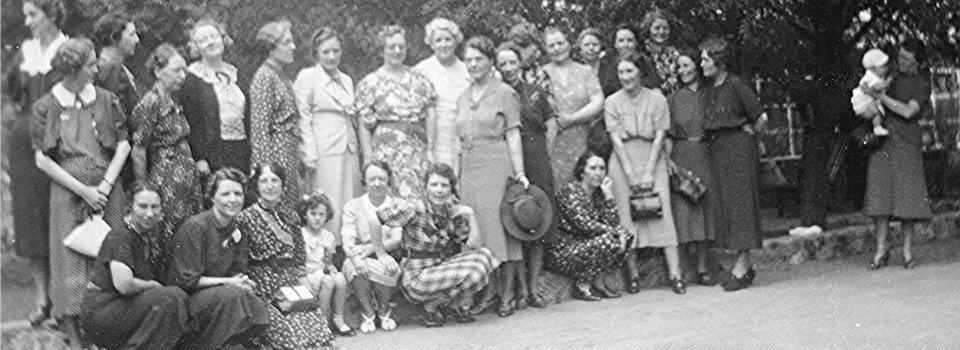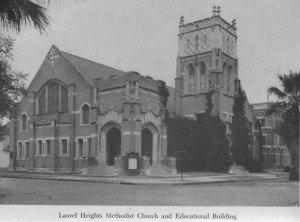
A History of Laurel Heights
Our Story
Rev. Jim Laney once said, “Every new building is a declaration.” Since 1909 Laurel Heights has declared: “When we gather in this place we believe that God is near, relationships are formed, and lives are changed. All are welcome here.”

1909: Founding
Laurel Heights United Methodist Church was founded in San Antonio, Texas on November 28, 1909. It grew from a need to establish a church within the new development of Monte Vista through the foresight of Mrs. J. O. Terrell, wife of Judge Terrell of San Antonio. The City Mission Board and Church Extension Society of San Antonio, the predecessor of the present Mission Board of San Antonio, purchased the northeast corner of West Woodlawn and Belknap Place for $8,000. J. D. Young was appointed as the first pastor of the church and very soon he was known affectionately to all as “Jim Dandy” Young. Meetings were initially held in a frame structure known as “The Tabernacle”. The Woman’s Missionary Society (now the United Methodist Women) was organized on November 28, 1909 with eight members.
1912: Sanctuary Built
On October 18, 1910, the Mission Board conveyed the property to the Board of Trustees and a charter to incorporate the Church was applied for later. The pastor moved the first shovel of dirt on May 1, 1911, and Bishop E. D. Mouzon laid the corner stone June 23, 1911. Construction was completed, and the Church was ready for the service on Easter Sunday, 1912, with Bishop S. Key preaching the sermon. The architect was Atlee B. Ayres, noted San Antonio architect, and the contractor Jack Haynes. The Epworth League (forerunner of the United Methodist Youth Fellowship) was organized in 1912 with 25 members.
1917-18: World War I
Laurel Heights practically adopted the 2300 soldier at the Balloon School at Camp John Wise (McCullough Ave and Olmos Dr). Wednesdays the young people of the church provided entertainments at the camp, Thursdays were designated for sewing and mending, and Friday nights the church was thrown open to the soldiers who came in large numbers.
1927: Construction of the Education Building
With a Sunday School enrollment of over 600 and 45 teachers, the church needed a new Education Building. In 1927 Construction began on a new 3 story building (with roof garden) designed by Adams and Adams. At the same time, the church undertook renovations to the Sanctuary building. The tower with its wooden spire, which had to be removed due to structural issues, was extensively remodeled and renamed the Moore Memorial Tower.

1936: The Messenger
The first issue of the Laurel Heights Messenger was mailed to church members on December 20, 1936. [The Messenger continues to be published today. Bound copies of all the back issues are available in the church library.]
1940s: Local and International Mission Work
In 1941 the Church sought to expand its support for local and international mission work beyond its historical obligations. The Local Welfare Committee’s first two recommendations were that church members be given “an opportunity to contribute to the needs of unfortunate people in the city” and that Laurel Heights should take particular care of the struggling Whosoever Mission founded by Rev. and Mrs. J.G. Pollard. In 1945 Laurel Heights contributed $10,000 to building the Bishop’s home and office in Mexico City, which were completed and dedicated in May 1946. During this time the church also supported Rev and Mrs. Bernardo Castex, missionaries in Chile, and William B. and Dorothy Smith, missionaries in Bolivia.
1950s: Defining Traditions
The 1950s saw the establishment of many programs and traditions that have come to define Laurel Heights today. In 1952, the Weekday Kindergarten or School in Christian Living (he Laurel Heights Weekday School) was established. In 1954 the Aeolian-Skinner Pipe Organ and an Echo organ were installed. In 1955 construction began on an expanded Educational and Activity Building (the gym and Weekday School Building). In 1958 the annual tradition of the Service of Lessons and Carols began.
1970s: More Beginnings
1975 was a significant year in several regards. The vibrant inter-faith group Super Adults began as a ministry to loneliness at the suggestion of Henry Holloway. The Weekday School hired its first full-time director, Betty Thomas. Sunday morning Fellowship time between the 8:30 service and Sunday School began. In 1976 the church purchased Schulmerish handbells and the Handbell Choir formed on May 21, 1976. There was also a significant renovation of the Sanctuary and beyond in 1977-79 that saw the church worshiping in the Dining Room.
1998: Brother Cletus Mural
The gym at Laurel Heights is home to A Celebration of Life, a wall mural in acrylic designed by Marianist artist Brother Cletus Behlmann. The mural includes religious and secular themes in a variety of styles from the abstract to the folk art tradition. The central leitmotif of his work proclaims the wonders of nature and the world in the light of God’s Redemption, all in celebration of life.
In the fall of 1998, Brother Cletus, working from a scaffold, designed the mural and indicated the colors to be used. Under the leadership of Harold and Juanita Souder, volunteers from the congregation painted the colorful mural.

2012: Installation of the Tower Bells
Although Laurel Heights had a tower, until 2012 it had never had a set of bells. In response to our 2010 Extravagant Generosity stewardship campaign, one of our members wanted to do something really extravagant for God, extravagant meaning having church bells for our Moore Memorial Tower. Over the next several months several other members contributed to the bells fund as well.
After much searching, Chime Master of Lancaster, Ohio found that St. Joseph Catholic Church of Mt. Oliver, Pennsylvania was selling three bells. Named St. Francis, St. Joseph and St. Agnes, the bells were originally cast and tuned by Petit & Fritzen of Holland in 1952 for the I. T. Verdin Company which acquired them for St. Joseph Catholic, a mostly German parish. St. Joseph had purchased the bells as part of a renovation project that they began in 1951 after a fire destroyed part of their church. St. Francis, St. Joseph and St. Agnes remained in the bell tower at St. Joseph until Laurel Heights United Methodist Church bought them in 2012 from Chime Master. They refurbished the bells before bringing them on a trailer to their new home in San Antonio, Texas. The notes the large bronze bells play are G, A and B. The largest bell, St. Joseph, rings in G.

2019-20: Exterior Refurbishment
In the fall of 2019, the congregation undertook a refurbishment of the exterior façade of the Sanctuary building.